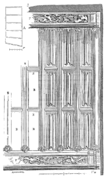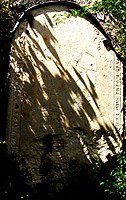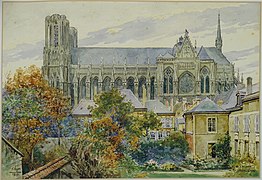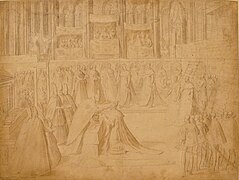Draft:Musée Le Vergeur
The content of this article is translated from the existing French Wikipedia article at fr:Musée-hôtel Le Vergeur; see its history for attribution.
 |
The Musée-Hôtel Le Vergeur is a museum located in Reims (Marne, Grand Est, France). The townhouse in which it is housed was classified as a historical monument on March 1, 1990[1].
The Building
[edit]It is located between the House of the Counts of Champagne and the Cryptoporticus. Situated on the Place du Forum at the corner of Rue du Marc.
-
The museum, its street-facing facades ;
-
on a map around 1880,
-
before World War I
-
after the war.
Named after Nicolas Le Vergeur, a 16th-century bourgeois who became wealthy thanks to the salt tax at the granary in Cormicy, the Musée-Hôtel Le Vergeur consists of two main buildings. One dates from the 13th century, originally owned by Eudes de Bourgogne, and the other from the 16th century, both of which were extensively modified after the First World War.
-
13th-century facade and 12th-century arches of the Temple of Reims,
-
French-style ceiling and
-
recorded by Viollet-le-Duc.
From the 13th-century building, the main surviving feature is a room with Gothic windows that once had a renowned French-style ceiling, partly famous due to mentions by Viollet-le-Duc.
In the 16th-century building along Rue du Marc, Nicolas Le Vergeur, baron of Challerange, viscount of Cramaille, and count of St-Souplet, significantly renovated the hotel in the Renaissance style. In the courtyard are two series of carvings. One series consists of eight medallions depicting faces, possibly portrait attempts. Above are six panels representing 16th-century society: the discovery of the Americas with feathered figures, horsemen in Oriental attire (with curved swords and turbans), the Le Vergeur family's coat of arms featuring a thistle and the motto "GLACE.SUR.OV.RIEN" (Chill on or nothing). The fourth panel depicts quarreling landsknechts, the fifth shows two knights in a tournament, and the sixth two reconciled landsknechts. In the cellar, a pillar bears the inscription "Here lies venerable religious Master Pierre Derclé, Doctor of Theology, former Prior here in 1486"[2].
-
cour renaissance, avant 1914,
-
en relevé avec les gravures
-
et détails ;
-
médaillons
-
bas relief
-
et pignon.
In 1662, the hotel passed to Nicolas Coquebert, who inscribed his monogram, an interlaced N and two Cs, on a first-floor window. The Beguin de Savigny family built the current porch on Rue du Marc and altered the windows.
In the 19th century, the hotel belonged to the Clicquot-Ponsardin family, who, owning the Champagne Couvert brand, named it "La Maison Couvert" before it passed to the Belleau family. Americans planned to purchase the 13th-century room and the Renaissance ceiling; however, a surge of local pride led the Rémois and the president of the SAVR, Hugues Krafft, to buy the entire building. During the First World War, it was largely destroyed, with only the walls remaining after a fire. Mr. Krafft had it reconstructed and restored as closely as possible to the original by architect Adolphe Prost (who also designed the Pharmacie Dieu-Lumière in a similar style). He made it his home and displayed his collections there. After his death in 1935, he bequeathed the entire property to the association, which turned it into the current museum. With its historical classification, the Société des amis du vieux Reims aimed to restore its character and purchased the building across Rue du Marc, now a square.
The Courtyard and Garden
[edit]The courtyard and garden feature a display of architectural remnants from the city: Romanesque arches from the 12th century from the former Templars' church, the 16th-century cloister portal from Saint-Pierre le Vieil, and the 17th-century portal from the Saint-Marcoul hospital, among others, in an intimate garden setting.
-
Tête de faune collectée à Reims et entreposée dans la cour du musée.
-
Le porche de l'hôpital Saint-Marcoul.
-
Gisant d'un chevalier du Temple.
The Museum
[edit]Established in 1932, the Musée Le Vergeur houses the collections amassed by Hugues Krafft during his life and extensive travels, and they remain the property of the Société des Amis du Vieux Reims. Since January 1, 2019, the Musée des Beaux-Arts has assumed the scientific management of the Musée Le Vergeur[3].
The Collections
[edit]The museum displays works dating from antiquity to the 20th century, including fifty engravings by Albrecht Dürer, Renaissance and neo-Gothic furniture, and 19th-century Asian and Oriental art collected during Hugues Krafft's extensive travels.
The museum also features reconstructed 19th-century rooms: bedrooms, a kitchen, a bathroom, a smoking room, etc. It also has a garden and an architectural promenade, and houses a Bleuette doll...
'''The Pommery Family'''
A donation from the Pommery family in the 1980s includes two busts representing Alexandrine Pommery and Louis Pommery, and two portraits of Madame Louis Pommery and Louis-Alexandre Pommery.
Watercolors by Eugène Auger
Painting called ''Rue de l'Écrevisse''.
-
La cour du chapitre par Auger,
-
Louise Pommery par Baschet,
-
statues en ivoire,
-
cheminée renaissance,
-
sacre de Henri III par Antoine Caron.
Notes and References
[edit]- ^ Mérimée
- ^ In Curiosités du pays de Champagne, extracted from Rheims by Tarbé, the hotel of the Couvert house in Rheims
- ^ https://musees-reims.fr/IMG/pdf/_1_-_le_petit_journal-reims_1920-1930._le_feu_de_la_creation_mai-novembre_2019_.pdf





















